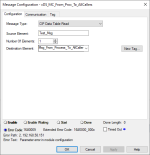theColonel26
Lifetime Supporting Member
Can anyone confirm that a 5380 with version 32 should be able to Read a UDT with a MSG instruction from itself?
I am trying to test some messaging code and I only have one 5380 PLC.
I am getting the a "Parameter Error in Module Configuration" error see screen shot.
I am new to messaging in AB so, maybe the issue is something else.
Goal Read a UDT from a remote tag, Goal for another instruction Write a UDT to a remote tag.

I am trying to test some messaging code and I only have one 5380 PLC.
I am getting the a "Parameter Error in Module Configuration" error see screen shot.
I am new to messaging in AB so, maybe the issue is something else.
Goal Read a UDT from a remote tag, Goal for another instruction Write a UDT to a remote tag.

Last edited:






